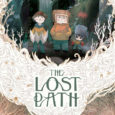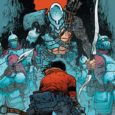First issues of new series have to be of the most challenging and difficult to write, if only because I find that so many teams fail at it. The struggle for a decent #1 is no mystery. Introduce characters, introduce conflict, introduce setting and lore and- Ye Gods!!- in only 22 pages! I can barely order food in McDonald’s clearly without spending three minutes staring slack-jawed at the menu and drooling incoherently. The perfect #1 (in comics, not in Big Macs), then, has to not only draw a reader into the universe, but hook you enough to drag you along for months to come. Best examples of a great first issues in recent months? The True Lives of the Fabulous Killjoys and East of West (each are past their first issue, but I’ve been playing catch up).

Both titles share qualities like amazing art, desert gunslingers, and similar structures that perhaps suggest that there is a pretty well-working formula for good number ones. Each book introduces three different subgroups and only several characters within each group. In Killjoys, we meet the remnants of the old guard resistance, some hapless porno droids, and the Better Life Industries representatives. In East of West, we have the three horsemen, Death and his crew, and leaders of the 7 Nations of America. The conflict before the impending conflict (which occurred before the first issue and set up the current world and situation for our characters) is touched upon and explained briefly in each as well. Where a lyrically blessed DJ waxed on the escapades of the glorious dead in Killjoys, East of West writer, Jonathan Hickman, used a more traditional flashback narrative to explain the division of the nations and prediction of the apocalypse.
What’s the magic of this formula? Well one that undoubtably wouldn’t create the illusion of an exciting new graphic universe if the writers and art sucked. But both teams are fan-freaking-tastic. The strength in this structure lies in the ability to tell a whole story in a small amount of panels, while also throwing in some set up for the rest of the series…but not too much. Leaving some mystery about the world, history and characters is key, which is why keeping the introductions down to a small number like 3 or 4 is ideal because, in only 22 pages, how else could a reader get to know enough to give a shit about any of them?

What’s essential here is the idea of universe building, not just character or story building. All three can be developed in the succeeding issues, but outside of established universes like in Marvel titles and the DCU, where your world has a basic foundation so the creative teams can focus more on plot and characters right out of the gate, the job of forging a fictional environment that has weight in just one issue is one almost impossible if a writer tries to do too much. Look at other similarities between these two titles that I’ve been fawning over. One creature was introduced in each, the draculoids in Killjoys and that bug-bot-thing in East of West. Each contained one sprawling city and outcropping settlement, and in other words only developed a limited number of settings. Readers are introduced to elements of the world, but have just enough to be undistracted from new characters and plot. The fact that each also shared other plot points like a pre-present day nuclear event and characters with bleached white skin is just neat and has made comparing the two titles all the more fun (though probably irrelevant to the successes of the story).
Balancing your storytelling in a #1 is an accomplishment of a masterful creative team and luckily for readers, The True Lives of the Fabulous Killjoys and East of West have some of the best.
What do you think goes in to a good number one?
Did you enjoy Way’s and Simon’s Killjoys or Hickman’s East of West?
















Well, and technically Killjoys is a first issue of this story, but as I mentioned in my review of the first issue (http://ihogeek.com/2013/06/12/killjoys1review/), it’s actually the continuation of an established universe from My Chemical Romance’s music videos from their “Danger Days” album.
But in getting readers to care about THIS set of characters, Way does admirably. It’s also, apparently, easy for people to jump into if they didn’t actually see the storylines of the “Na Na Na (Na Na Na Na Na Na Na Na Na Na)” and “Sing” videos.
it totally is easy to jump in to. i only looked up the videos for those songs in poking around for this article. It made me appreciate them a lot more